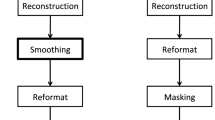Abstract
Background
Myocardial perfusion scintigraphy (MPS) represents a key prognostic tool, but its predictive yield is far from perfect. We developed a novel clinically relevant segmentation method and a corresponding maximal ischemia score (MIS) in order to risk-stratify patients undergoing MPS.
Methods
Patients referred for MPS were identified, excluding those with evidence of myocardial necrosis or prior revascularization. A seven-region segmentation approach was adopted for left ventricular myocardium, with a corresponding MIS distinguishing five groups (no, minimal, mild, moderate, or severe ischemia). The association between MIS and clinical events was assessed at 1 year and at long-term follow-up.
Results
A total of 8,714 patients were included, with a clinical follow-up of 31 ± 20 months. Unadjusted analyses showed that subjects with a higher MIS were significantly different for several baseline and test data, being older, having lower ejection fraction, and achieving lower workloads (P < .05 for all). Adverse outcomes were also more frequent in patients with higher levels of ischemia, including cardiac death, myocardial infarction (MI), and their composites (P < .05 for all). Differences in adverse events remained significant even after extensive multivariable adjustment (hazard ratio for each MIS increment = 1.57 [1.29-1.90], P < .001 for cardiac death; 1.19 [1.04-1.36], P = .013 for MI; 1.23 [1.09-1.39], P = .001 for cardiac death/MI).
Conclusions
Our novel segmentation method and corresponding MIS efficiently yield satisfactory prognostic information.






Similar content being viewed by others
References
Beller GA. First annual Mario S. Verani, MD, Memorial lecture: Clinical value of myocardial perfusion imaging in coronary artery disease. J Nucl Cardiol 2003;10:529-42.
Clark AN, Beller GA. The present role of nuclear cardiology in clinical practice. Q J Nucl Med Mol Imaging 2005;49:43-58.
Cerqueira MD, Weissman NJ, Dilsizian V, Jacobs AK, Kaul S, Laskey WK, et al. Standardized myocardial segmentation and nomenclature for tomographic imaging of the heart. A statement for healthcare professionals from the Cardiac Imaging Committee of the Council on Clinical Cardiology of the American Heart Association. J Nucl Cardiol 2002;9:240-5.
Hachamovitch R, Hayes SW, Friedman JD, Cohen I, Berman DS. Stress myocardial perfusion single-photon emission computed tomography is clinically effective and cost effective in risk stratification of patients with a high likelihood of coronary artery disease (CAD) but no known CAD. J Am Coll Cardiol 2004;43:200-8.
Kang SJ, Cho YR, Park GM, Ahn JM, Han SB, Lee JY, et al. Predictors for functionally significant in-stent restenosis: An integrated analysis using coronary angiography, IVUS, and myocardial perfusion imaging. JACC Cardiovasc Imaging 2013;6:1183-90.
Hansen CL, Goldstein RA, Akinboboye OO, Berman DS, Botvinick EH, Churchwell KB, et al. Myocardial perfusion and function: Single photon emission computed tomography. J Nucl Cardiol 2007;14:e39-60.
Vaduganathan P, He ZX, Vick GW 3rd, Mahmarian JJ, Verani MS. Evaluation of left ventricular wall motion, volumes, and ejection fraction by gated myocardial tomography with technetium 99m-labeled tetrofosmin: A comparison with cine magnetic resonance imaging. J Nucl Cardiol 1999;6:3-10.
Cerci RJ, Arbab-Zadeh A, George RT, Miller JM, Vavere AL, Mehra V, et al. Aligning coronary anatomy and myocardial perfusion territories: An algorithm for the CORE320 multicenter study. Circ Cardiovasc Imaging 2012;5:587-95.
Candell-Riera J, Ferreira-González I, Marsal JR, Aguadé-Bruix S, Cuberas-Borrós G, Pujol P, et al. Usefulness of exercise test and myocardial perfusion-gated single photon emission computed tomography to improve the prediction of major events. Circ Cardiovasc Imaging 2013;6:531-41.
DePasquale EE, Nody AC, DePuey EG, Garcia EV, Pilcher G, Bredlau C, et al. Quantitative rotational thallium-201 tomography for identifying and localizing coronary artery disease. Circulation 1988;77:316-27.
Berman DS, Kiat H, Friedman JD, Wang FP, van Train K, Matzer L, et al. Separate acquisition rest thallium-201/stress technetium-99m sestamibi dual-isotope myocardial perfusion single-photon emission computed tomography: A clinical validation study. J Am Coll Cardiol 1993;22:1455-64.
Pereztol-Valdés O, Candell-Riera J, Santana-Boado C, Angel J, Aguadé-Bruix S, Castell-Conesa J, Garcia EV, Soler-Soler J. Correspondence between left ventricular 17 myocardial segments and coronary arteries. Eur Heart J 2005;26:2637-43.
Hachamovitch R, Hayes SW, Friedman JD, Cohen I, Berman DS. Comparison of the short-term survival benefit associated with revascularization compared with medical therapy in patients with no prior coronary artery disease undergoing stress myocardial perfusion single photon emission computed tomography. Circulation 2003;107:2900-7.
Shaw LJ, Berman DS, Maron DJ, Mancini GB, Hayes SW, Hartigan PM, et al. Optimal medical therapy with or without percutaneous coronary intervention to reduce ischemic burden: Results from the Clinical Outcomes Utilizing Revascularization and Aggressive Drug Evaluation (COURAGE) trial nuclear substudy. Circulation 2008;117:1283-91.
Disclosures
All authors have no funding or conflict of interest to disclose.
Author information
Authors and Affiliations
Corresponding author
Additional information
See related editorial, doi:10.1007/s12350-014-9929-x.
Electronic supplementary material
Below is the link to the electronic supplementary material.
Rights and permissions
About this article
Cite this article
Nudi, F., Pinto, A., Procaccini, E. et al. A novel clinically relevant segmentation method and corresponding maximal ischemia score to risk-stratify patients undergoing myocardial perfusion scintigraphy. J. Nucl. Cardiol. 21, 807–818 (2014). https://doi.org/10.1007/s12350-014-9877-5
Received:
Accepted:
Published:
Issue Date:
DOI: https://doi.org/10.1007/s12350-014-9877-5




